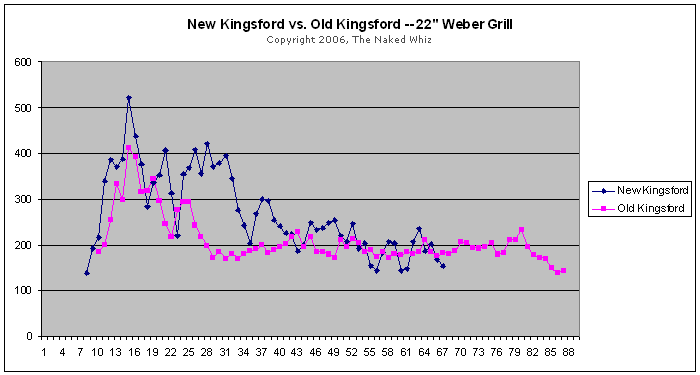Why Part 2?
You may remember that there has been quite a bit of discussion on various barbecue forums recently over the change that Kingsford made to their briquettes. Kingsford claims that these new briquettes with "Sure Fire Grooves" burn longer and only "slightly hotter" among a host of other claims. So, we undertook the task of running some tests to validate these claims (or not) and published our results on this webpage. It should come as no surprise then, that we were enormously amused when Kingsford subsequently published this document in which they discuss how to test charcoal, among other things. (Note, you need Adobe Acrobat Reader to display their file.)
Amused first of all, simply because the document must have been written by the marketing staff. While it purports to explain how to conduct a scientific test, it uses the terms "mass" and "weight" interchangebly. Nope, no scientist wrote this stuff. But, what is also amusing is their indirect reference to our testing. We quote, "It is likely that a barbecuer using Kingsford Charcoal with Sure Fire Grooves on a kettle-style grill will get different results from someone using a Big Green Egg® or a low and slow charcoal smoker."
We were so amused that we decided to run another test in another cooker to see if some of their claims still ring false or not. We recently did a non-published comparison between the new Kingsford and a natural briquette that is made only from a vegetable starch binder and ground charcoal. So, we thought we would repeat the test, but with old Kingsford compared to new Kingsford. This test was conducted in a Weber 22" kettle grill. Kingsford indicates that barbecuers would get different results in a kettle-style grill, so let's see if they are right!
Old Kingsford vs. New Kingsford in a Weber 22" Kettle
The Test:
Three pounds of each product were weighed and piled in the center of the charcoal grill on a 22" Weber kettle. The product was soaked with 5 ounces of starter fluid and lit. Once the flames disappeared and the fire was going, we spread the briquettes sufficiently to produce a 2 briquette layer of charcoal. Temperatures were measured at one-minute intervals using a Stoker and a 1000-degree probe. The probe was clipped to the center of the cooking grid with the tip of the probe one inch above the grid.
The Results:
The following chart should make the results pretty clear:

Conclusion:
Two things should be immediately obvious: First, new Kingsford burns quite a bit hotter (not "slightly hotter") than old Kingsford. (Which is what we said the first time around...) Second, as a result, new Kingsford burns faster and thus doesn't last as long as old Kingsford. (In our previous test where we burned both charcoals at the same temperature, they both burned about the same length of time.) But also note the way new Kingsford exhibits much greater swings in temperature than old Kingsford. Old Kingsford burns lower, slower and more consistently than new Kingsford.
It looks like all the complaints on barbecue forums about the new Kingsford burning hotter and therefore not as long are STILL valid. Cooks who can control the airflow on their cookers should be able to adjust to this new product, but perhaps with a less consistent burn. Many cooks, however, cannot and based on their comments on barbecue forums, are choosing to switch to other brands while hoping that Kingsford follows the lead of Coca-Cola and comes out with Classic Kingsford.

